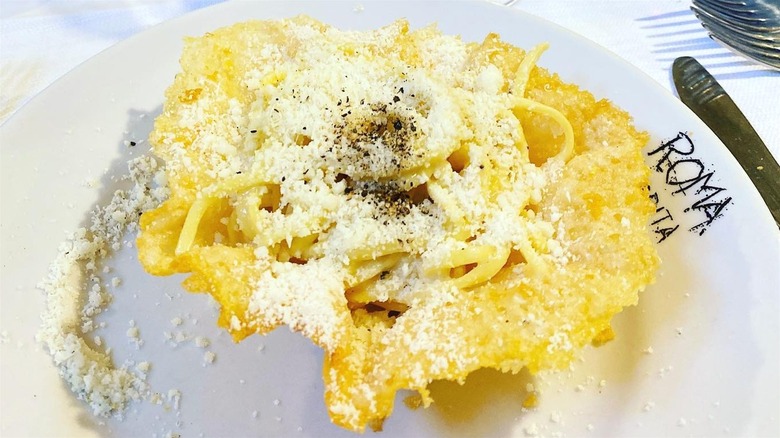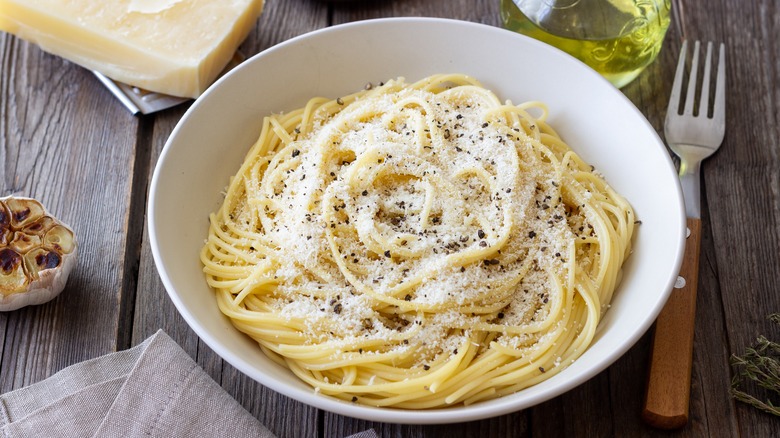Anthony Bourdain's Favorite Pasta Dish Is A Comforting Classic
During his TV career, Anthony Bourdain filmed three episodes in Rome. But, he didn't go there for the usual tourist attractions; Bourdain, of course, went for the food. While he enjoyed a wide variety of Italian gustatory delights, it was traditional Roman cuisine that kept him coming back for more. One meal in particular, cacio e pepe, became his favorite pasta dish — he sang its praises as a necessity when traveling.
Cacio e pepe translates to cheese and pepper in Italian, and along with pasta and water, that's usually the extent of its ingredients. While not difficult to make, the deceptively simple recipe does require a bit of technique to perfect. It can be made with Parmigiano Reggiano or parmesan cheese, but truly authentic versions use Pecorino Romano. Spaghetti or other long noodles are cooked to al dente, then mixed with the cheese, black pepper, and just the right amount of starchy pasta water. The hot water melts the cheese, transforming into a rich cremina sauce that coats the noodles.
On his initial trip to Rome, for a 2009 episode of "No Reservations," Bourdain visited an undisclosed restaurant to try the dish for the first time. It was so good that he said it had to be "illegal somewhere." The culinary personality then went on to declare it "the greatest thing in the history of the world," before listing past experiences he would sacrifice in order to eat it and philosophized on "what bleak meaningless existences we'd have without [it]."
When in Rome, eat Bourdain's favorite dish
Anthony Bourdain tried cacio e pepe a few times on his various series — and if you want to follow his footsteps, here's where to go when in Rome. While he didn't name the initial restaurant where he tried cacio e pepe in 2009 (in order to preserve its local charm), fans eventually figured it out to be Ristorante Roma Sparita, a family-owned eatery located in the Trastevere neighborhood. Locals for sure still love eating there, but it has subsequently become an international foodie destination.
Even though the dish is common throughout Rome, Roma Sparita's version has a few things that set it apart. The first is the addition of butter, which is not a customary ingredient for this dish but it helps to create an exceptionally rich sauce, and brings out the saltiness of the Pecorino. The second difference is that the restaurant makes the dish with the thicker, egg-based tagliolini instead of spaghetti, which is more complementary to cheese and cream-based sauces. Roma Sparita also serves it in a scrumptious edible bowl made of crisped up parmesan cheese.
In the 2011 Rome-based episode of "The Layover," Anthony Bourdain also enjoyed the pasta dish at a restaurant that's literally named after it, Cacio e Pepe, located near Lepanto station. Bourdain advised that if you do only one thing while in the Italian capital, you should skip touring the Vatican and instead sample cacio e pepe — and enjoy it with a jug of wine (via Travel Channel).
Quality ingredients matter when making cacio e pepe
The origins of cacio e pepe go back to ancient Rome when shepherds would leave home for months-long journeys and needed food to sustain them; the ingredients of the pasta dish did the trick. Pecorino is an aged sheep's milk cheese, which doesn't spoil easily; black pepper speeds up metabolism due to its thermogenic properties, a plus for keeping shepherds warm on cold nights; and high carbohydrate pasta provided energy throughout the day.
If you want to try making it at home, this is a dish where you similarily don't want to skimp on quality, since it has so few ingredients and you'll want each to come through. For Martha Stewart's three-ingredient cacio e pepe recipe, she recommends using high-quality pasta that will soak up the sauce. That's not the only reason to splurge on the good stuff — the better the pasta, the more starch it will release into the cooking water, which is key to making the fantastic sauce. As for the cheese, you can get away with using Pecorino Romano vs parmesan interchangeably, but in this case, parmesan is the less authentic option.
When it comes to the dairy though, cheese sauces are notorious for seizing up. This usually happens when too much heat causes the moisture to evaporate, resulting in a coagulated blob. Thankfully, Giada De Laurentiis' has a tip to prevent clumpy cacio e pepe: Simply remove the pan from the heat before adding the cheese.



